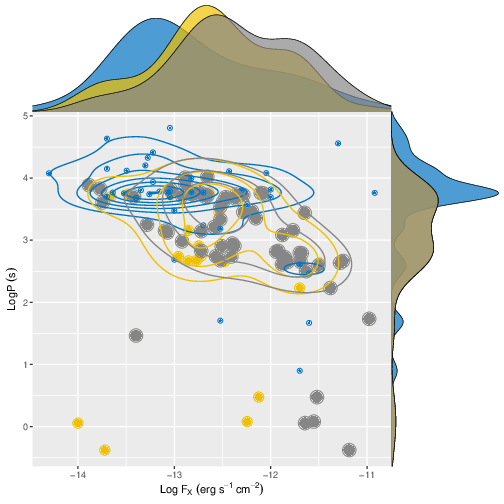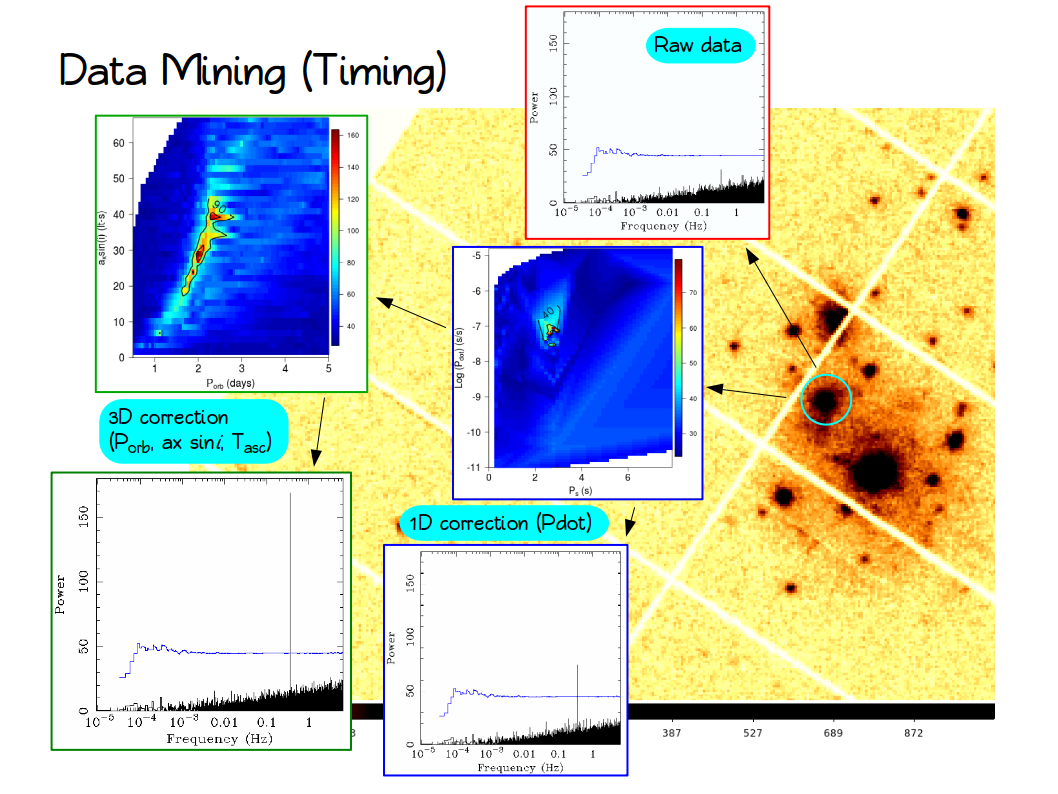Data Mining and Signal Search (in the X-ray band)


The detection of X-ray coherent signals, in general reflecting the rotation of a compact object or the orbital motion in a binary system, plays a role of paramount importance in unveiling the nature of a source, inferring its main properties and testing accretion/evolutionary models. In the past, it led to the identification of new classes of celestial objects and/or new emission mechanisms. Few examples in which the modulation is due to the compact star spin are: (a) accreting magnetic neutron stars (NSs) in X-ray binary systems; (b) spinning down isolated NSs, the emission of which is powered by the dissipation of rotational, thermal or even magnetic energy (as in the cases of ‘ordinary’ radio pulsars, X-ray dim isolated NSs and magnetars, respectively); (c) magnetic white dwarf (WD) systems, such as polars and intermediate polars. Orbital modulation of the X-ray flux is observed in a number of X-ray binaries and cataclysmic variables (CVs) of various classes.
In general, the discovery of the modulation takes place through the timing analysis (mainly Fourier techniques) of the light curves of the sources detected in the field of view of a pointed observation. It is therefore evident how rewarding can be the systematic analysis of a large number of light curves with good statistics. During the ’90s researchers of our team carried out systematic timing analyses of relatively bright serendipitous sources (about 50000 objects) detected by EXOSAT, ROSAT and ASCA which resulted in the identification of sources which have become prototypes of new classes: e.g. Anomalous X-ray pulsars [1], the double degenerate X-ray binaries hosting two WDs with the shortest orbital period (5.4 minutes; [2]), the X-ray emission of which might be powered through an electromagnetic force originated by a non-magnetic WD moving through the magnetic field of the primary WD [3], and X-ray pulsators in extremely rare evolutionary phases of binaries such as the sub-dwarf O-type star HD 49798, which hosts the fastest spinning-up WD observed so far (13 s X-ray pulsations), which is also likely to evolve into a Ia supernova [4,5].
Thanks to the present generation of high energy imaging missions such as XMM-Newton and Chandra,
which cover wide energy ranges with high sensitivity, the number of detected X-ray serendipitous sources
has boomed by a factor of more than 10. In the last 8 years, we have applied the ‘state-of-the-art’ timing techniques to carry out a systematic search for X-ray pulsators in the XMM and Chandra archives ( > 800.000 light curves); Exploring the X-ray Transient and variable Sky, aka EXTraS [6], and ChAndra Timing Survey at Brera And Roma astronomical observatories, aka CATS@BAR [7]. Among the several results obtained so far, there are the identification of a number of intrinsically-faint X-ray pulsators and the extension of the luminosity interval over which the physics of the pulsed emission mechanisms can be investigated. In particular, at low luminosity (therefore, low accretion rates Ṁ ), only NSs with long spin periods and/or low magnetic fields can satisfy the condition that the corotation radius is larger than the magnetospheric one, so that the matter can reach the NS surface at the polar caps, and spin pulses can be detected. At the highest luminosity, we found the pulsating ultraluminous x-ray sources (PULXs) in distant galaxies [8,9,10], and the first two X-ray pulsars discovered in the Andromeda galaxy [11, 12].
The sample of new pulsators currently counts more than 100 objects and only for about 10% of the total it has been possible to assess the nature of the signal and/or of the compact object. This is a living project since data from Chandra and XMM are continuously stored in the archives. Many new pulsators await to be discovered and studied.
Furthermore, the extreme timing properties of PULXs (orbital motion plus strong first period derivative) forced us to develop/use new timing tools able to maximize the probability of detecting such signals. The above Figure (right panel) shows the capability of these techniques to recover the original signal depending on the number of free parameters [13].
If you are interested in a thesis regarding data mining here you can find available theses about this topic.
Involved group members: Gianluca Israel, Matteo Imbrogno, Arianna Miraval Zanon, Guillermo Rodriguez (currently at OA Palermo)
References
[1] Israel, G. L., Mereghetti, S., Stella, L., 1994, The Astrophysical Journal, 433, L25, "The Discovery of 8.7 Second Pulsations from the Ultrasoft X-Ray Source 4U 0142+61"
[2] Israel, G. L., Hummel, W., Covino, S., Campana, S., Appenzeller, I., Gässler, W., Mantel, K.-H., Marconi, G., et al., 2002, Astronomy and Astrophysics, 386, L13, "RX J0806.3+1527: A double degenerate binary with the shortest known orbital period (321s)"
[3] Dall'Osso, S., Israel, G. L., Stella, L., 2007, Astronomy and Astrophysics, 464, 417, "Unipolar inductor model coupled to GW emission: energy budget and model application to RX J0806+15 and RX J1914+24"
[4] Israel, G. L., Stella, L., Angelini, L., White, N. E., Kallman, T. R., Giommi, P., Treves, A., 1997, The Astrophysical Journal, 474, L53, "The Discovery of 13 Second X-Ray Pulsations from the Hydrogen-depleted Subdwarf O6 Star Binary HD 49798"
[5] Mereghetti, S., Tiengo, A., Esposito, P., La Palombara, N., Israel, G. L., Stella, L., 2010, X-ray Astronomy 2009; Present Status, Multi-Wavelength Approach and Future Perspectives, 1248, 85, "The discovery of a massive white dwarf in the peculiar binary system HD 49798/RX J0648.0-4418"
[6] De Luca, A., Salvaterra, R., Belfiore, A., Carpano, S., D'Agostino, D., Haberl, F., Israel, G. L., Law-Green, D., et al., 2021, Astronomy and Astrophysics, 650, A167, "The EXTraS project: Exploring the X-ray transient and variable sky"
[7] Israel, G. L., Esposito, P., Rodríguez Castillo, G. A., Sidoli, L., 2016, Monthly Notices of the Royal Astronomical Society, 462, 4371, "The Chandra ACIS Timing Survey Project: glimpsing a sample of faint X-ray pulsators"
[8] Israel, G. L., Belfiore, A., Stella, L., Esposito, P., Casella, P., De Luca, A., Marelli, M., Papitto, A., et al., 2017, Science, 355, 817, "An accreting pulsar with extreme properties drives an ultraluminous x-ray source in NGC 5907"
[9] Israel, G. L., Papitto, A., Esposito, P., Stella, L., Zampieri, L., Belfiore, A., Rodríguez Castillo, G. A., De Luca, A., et al., 2017, Monthly Notices of the Royal Astronomical Society, 466, L48, "Discovery of a 0.42-s pulsar in the ultraluminous X-ray source NGC 7793 P13"
[10] Rodríguez Castillo, G. A., Israel, G. L., Belfiore, A., Bernardini, F., Esposito, P., Pintore, F., De Luca, A., Papitto, A., et al., 2020, The Astrophysical Journal, 895, 60, "Discovery of a 2.8 s Pulsar in a 2 Day Orbit High-mass X-Ray Binary Powering the Ultraluminous X-Ray Source ULX-7 in M51"
[11] Esposito, P., Israel, G. L., Belfiore, A., Novara, G., Sidoli, L., Rodríguez Castillo, G. A., De Luca, A., Tiengo, A., et al., 2016, Monthly Notices of the Royal Astronomical Society, 457, L5, "EXTraS discovery of an 1.2-s X-ray pulsar in M31"
[12] Rodríguez Castillo, G. A., Israel, G. L., Esposito, P., Papitto, A., Stella, L., Tiengo, A., De Luca, A., Marelli, M., 2018, The Astrophysical Journal, 861, L26, "Discovery of a 3 s Spinning Neutron Star in a 4.15 hr Orbit in the Brightest Hard X-Ray Source in M31"
[13] Israel, G. L., Rodriguez Castillo, G. A., UNSEEN Collaboration, 2019, Memorie della Societa Astronomica Italiana, 90, 216, "The extragalactic population of neutron stars: the ULX paradigm revolution"